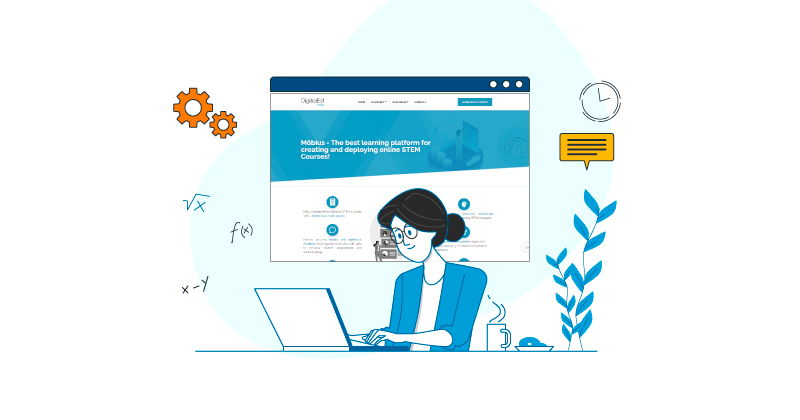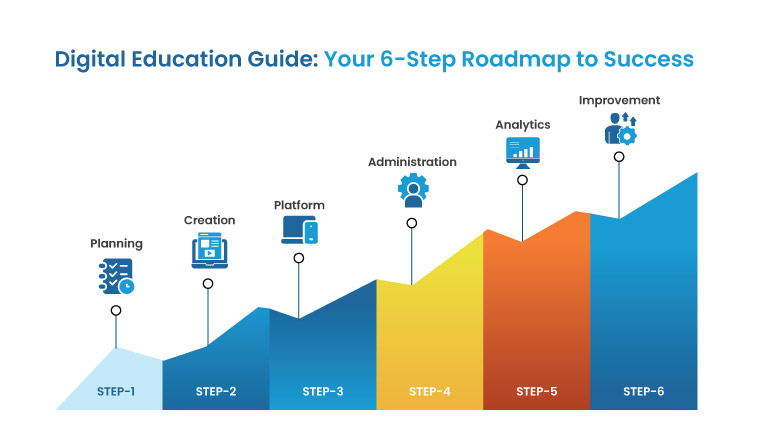Digital Learning Landscape: A 6-Step Guide to Success

The past few years have witnessed a seismic shift in the educational landscape. Traditional textbooks, once the cornerstone of learning, are increasingly being replaced by digital learning resources like videos and eNotes. This digital revolution has ushered in an era of engaging, dynamic, and interactive learning experiences for students.
Videos bring abstract concepts to life, leaving a lasting impression. eNotes, meanwhile, offer a customizable and accessible portal to knowledge, empowering learners to delve deeper from anywhere, at any time. This diverse array of digital learning materials, including e-books, podcasts, simulations, and games, provides an avenue for deeper understanding and increased engagement.
Harnessing the Power of Digital Learning
Digital learning undoubtedly holds immense potential to revolutionize education. However, its effectiveness hinges on proper utilization. Many educators grapple with integrating these resources effectively, hindering students from reaping the full benefits.
One key challenge lies in distinguishing between content best suited for digital delivery and concepts requiring in-person instruction. Additionally, navigating the vast landscape of digital platforms to find the optimal fit for diverse learning styles can be daunting.
To overcome these hurdles, educators require a structured approach encompassing meticulous planning, platform selection, effective management, ongoing evaluation, and continuous adaptation. By orchestrating these steps, educators can maximize the impact of digital learning resources, leading to enhanced learning outcomes and a more rewarding educational experience.
Stay tuned as we delve deeper into the six key steps that empower educators to master the art of digital learning management, propelling their students towards academic success.
6 Steps to Successful Digital Education

1. Strategic Planning:
Before embarking on your digital expedition, chart your course meticulously. Review your existing curriculum, objectives, and assessment methods. Prioritize content that directly supports your learning goals. Convert key information into interactive formats, enriching your students’ experience.
Categorize remaining material as foundational, remedial, supplementary, or potentially distracting. Remember, time is precious, both for content creation and face-to-face interactions.
2. Content Creation:
Digital courses offer a vibrant tapestry of learning materials: images, videos, text, and animations. However, simply replicating traditional materials onto an online platform falls short. To truly captivate your students, actively engage them by adapting and refining your content. For instance, enhance accessibility by transcribing or captioning videos. Cater to diverse learning styles by providing materials in multiple formats and utilizing short, focused videos for in-depth explanations.
It is essential to make a connection between traditional classes and online classes by being clear about what content needs to be explained in text and what needs to be described through online platforms.
After meticulous course planning, the next critical step is selecting a platform. The school’s Learning Management System (LMS) serves as an excellent starting point, efficiently managing administrative tasks and providing familiar tools. However, certain courses may benefit from third-party tools like video conferencing or technical notation.
Integration of these tools into the LMS enhances the overall learning experience, ensuring organization. Prioritize platforms harmonized through Learning Tool Interoperability (LTI) to facilitate easy access to external materials and seamless grade integration into the LMS gradebook. This strategic integration promotes a cohesive and efficient educational environment.
3. Platform Selection:
When faced with the task of choosing a platform for delivering content that encompasses multimedia and advanced mathematical resources, it becomes imperative to consider several critical factors. The chosen platform should seamlessly support various multimedia formats while effortlessly incorporating equations and other mathematical elements.
Furthermore, it must offer an automatic grading feature, facilitating efficient assessment of student learning outcomes and contributing to time-saving measures. Accessibility from multiple devices is crucial, ensuring ease of navigation for both instructors and students. Cost-effectiveness and scalability are paramount, enabling efficient and effective content creation and delivery irrespective of the course’s size or the number of enrolled students.
4. Streamlining Administration:
Following the platform selection, the next pivotal step is effective administration, wherein instructors must proficiently manage various facets of the learning experience. This encompasses tasks such as course enrollment, user account management, assessments, and other logistical responsibilities. Effective administration guarantees that students are appropriately enrolled, provided access to course materials, and receive prompt feedback on their progress.
Moreover, it aids instructors in efficiently handling the platform’s workload, ensuring the smooth functioning of the course. By prioritizing streamlined administrative tasks, instructors can cultivate a positive and engaging learning environment for their students.
5. Data-Driven Insights:
Leveraging an online platform for course delivery provides educators with an extensive pool of data on student performance and engagement. The platform’s automatic grading feature not only assesses assignments but also records crucial information such as time taken, student preferences, and submitted answers.
Furthermore, it allows for tracking and accessing additional data for more comprehensive insights, including student login times, duration spent on lessons, video-watching frequency, and completion rates for inline exercises. Analyzing this wealth of data offers a holistic view of the class’s overall performance and individual student achievements, empowering instructors to make informed decisions for continual course improvement.
6. Enhancing Learning Experience:
Online learning platform analytics enable instructors to refine course content for better student understanding. This includes updating material, changing lesson sequences, and adding extra resources. Insights from analytics also enhance traditional teaching methods, allowing instructors to preemptively address common questions and create a smoother learning experience.
By analyzing data, teachers identify gaps in knowledge among learners and personalize the learning journey for them, making it more engaging for both online and traditional classes. Insights identify areas of struggle, enabling adjustments to content or delivery methods. Popular online activities can seamlessly integrate into traditional classes, creating a more dynamic and effective learning environment.
E-Learning Excellence: Möbius Recommendation
Möbius, by DigitalEd India, stands out as an exceptional choice for educators seeking a versatile learning management system for distance and blended learning. This platform provides instructors with the dynamic capability to craft content using diverse multimedia formats and templates. It allows seamless customization of questions and assessments to align with specific instructional needs while efficiently generating multiple algorithmic questions in one go. Möbius sets itself apart by automating the grading of mathematical expressions, text, and numeric answers, simplifying the assessment process.
Adding students and instructors is a swift task through Möbius, achieved effortlessly with a bulk upload feature utilizing a spreadsheet of student details. The platform’s advanced digital analytics board empowers instructors with real-time insights into student behavior, progress tracking, and the identification of areas that may require improvement. A notable feature is the ability to restrict access to subsequent lessons until students successfully complete preceding chapters, ensuring a structured and progressive learning path.
Moreover, Möbius facilitates continuous improvement by allowing instructors to adapt content based on valuable student feedback throughout the platform. This adaptability enhances the overall learning experience, fostering a responsive and engaging digital education ecosystem.
In conclusion, the benefits of digital learning, including enhanced accessibility, flexibility, and personalization, are paramount for both learners and educators. Möbius, with its user-friendly interface, personalized learning experiences, multiple digital assessment pathways, collaboration tools, and interactive content, emerges as an exemplary platform. It not only aligns with the contemporary needs of digital education but also offers a comprehensive suite of features to support effective and engaging learning experiences.
Intrigued? Book a personalized demo today!
Author
Deepali Singh